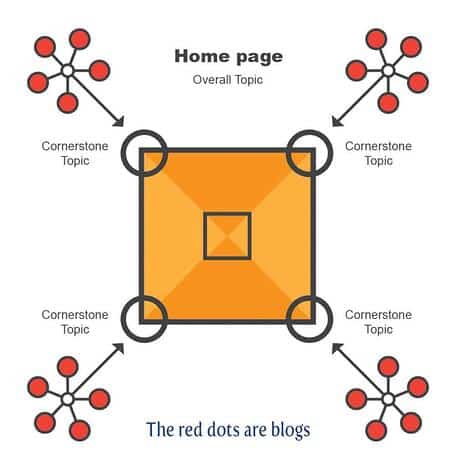Cornerstone Content of p5marketing
As I was laying the cornerstone for my new house, I realized how similar it was to creating cornerstone content for a website. Both require a solid foundation. Both set the tone for everything that follows.
For those unfamiliar with the term, cornerstone content is the foundation upon which a website or blog builds its identity and authority. High-quality, in-depth, and valuable content attracts visitors and keeps them returning. This type of content is crucial in establishing your website as a trusted authority on key topics.
This article will explore the importance of high-quality articles, how to identify your key topics and strategies for writing effective posts. We’ll also delve into keywords’ critical role in SEO optimization.
Like a well-laid cornerstone, effective cornerstone content can support the structure of your online presence and lead to greater success.
– Cornerstone content is the foundation of a website or blog, attracting and retaining visitors with high-quality content.

Cornerstone Content Key Takeaways
– High-quality articles are crucial for establishing credibility and engaging the audience, building trust and authority over time.
– Quality, consistency, and structure are important in writing effective posts, ensuring a positive user experience.
– Strategic keyword research and integration are essential for SEO optimization, and enhancing blog visibility.
The Importance of High-Quality Articles for Cornerstone Content
Without a doubt, high-quality articles are the heart and soul of your content strategy, and without them, it’s like a ship lost at sea. They serve as the foundation, the bedrock from which all other content efforts spring.
High-quality content not only establishes your brand’s credibility but also engages and retains your audience, keeping them coming back for more. It’s crucial to understand that creating high-quality content doesn’t just mean writing a lot. It’s about crafting well-researched, informative, and engaging pieces that resonate with your audience.
It’s about offering value, solving problems, and providing insights that your readers can’t find anywhere else. And it’s not just about words on a page – it’s about creating a comprehensive, cohesive narrative that tells your brand’s story.
But having fantastic articles is just the beginning – you also need to know what to write about. You need to identify your key topics and the subjects that matter to your audience. This is where the hard work begins, diving deep into those topics and making them the centerpiece of your content strategy.
On to the next challenge – identifying your key topics.
Identifying Your Cornerstone Content Key Topics
Digging deep and identifying your central themes can feel overwhelming, yet it’s the heart-pumping adventure that leads us to the goldmine of our brand’s core message. This journey begins with asking ourselves some crucial questions: What topics I’m most passionate about? What am I an expert in? What do I want to be known for? These questions guide us to discover our key topics.
Once we’ve identified these themes, we must delve into each one, exploring their depths and nuances. This in-depth exploration allows us to create comprehensive, cornerstone content. The goal is to create a body of work that thoroughly covers our key topics, providing immense value to our readers while positioning us as an authority in our niche.
This process may seem daunting, but the reward is immense. High-quality, cornerstone content helps us establish a strong online presence and attract a dedicated audience that values our expertise. It’s through this diligent work that we begin to build trust and authority in our niche, which serves as an excellent launch pad for the next aspect of our branding journey: building relationships with our audience.
Building Trust and Authority
Once you’ve established your key topics and created a robust body of work around them, it’s time to focus on fostering trust and authority with your audience. This can seem daunting, but it’s quite simple when broken down. Trust and authority are not created overnight – they are built slowly, one piece of content at a time.
The first thing you need to do is to ensure that your content is of high quality. It needs to be well-researched, well-written, and most importantly, provide value to your audience. People are much more likely to trust and respect you if they can see that you know what you’re talking about and that you’re putting in the effort to create something worthwhile.
In addition to quality, consistency is also key. If you’re constantly putting out great content, your audience will come to rely on you as a trusted source of information. This is how you build authority – by proving that you’re someone who consistently delivers.
Now, let’s move on and delve into the strategies that will help you craft posts that not only build trust and authority but also engage and captivate your audience.
Strategies for Writing Effective Posts
Navigating the sea of blogging can be tricky, but with the right strategies in place, you can craft posts that establish your authority and hook your audience from start to finish. The key is to create cornerstone content – material that reflects your mission, showcases your expertise, and serves as a pillar for your blog.
Please review our cornerstone content strategy page
Firstly, I always ensure that my posts are informative and engaging. It’s essential to present valuable information that resonates with my readers. I use anecdotes, personal experiences, and a conversational tone to make my posts relatable and easily read.
Secondly, I focus on consistency. Regularly publishing high-quality content not only helps me to build trust with my audience but also boosts my credibility in the eyes of search engines.
Lastly, I ensure that my content is well-structured. Clear headings, short paragraphs, and bullet points make my posts easy to scan and digest.
These strategies have served me well in crafting effective posts. Now, to further enhance my blog’s visibility, it’s time to delve into the intricacies of keyword usage in SEO optimization.
The Role of Keywords in SEO Optimization
You’ve got to understand that using keywords plays an integral role in SEO optimization, making your blog more visible to your target audience.
When it comes to writing cornerstone content, it’s essential to do keyword research diligently, identifying words or phrases that your potential readers are likely to use when searching for information on the topic you’re writing about.
In addition, it’s crucial to use these keywords strategically within your content. Stuffing your posts with keywords will do more harm than good, as search engines might perceive it as spam. Instead, it would be best to focus on creating high-quality content that naturally incorporates the keywords.
But remember, keywords aren’t just for your content body. They should also be included in your meta descriptions, titles, and even your URL. This helps search engines understand what your content is about, ultimately improving your search ranking.
It’s not about bombarding your content with keywords; it’s about smartly integrating them into your post while ensuring it’s still engaging, informative, and reader-friendly.
So, go ahead, get your keywords right, and watch your blog visibility increase exponentially.
Conclusion
In this digital age, creating cornerstone content is no longer a luxury but a necessity. It’s all about quality over quantity, folks.
Remember, Rome wasn’t built in a day. So, craft compelling posts, stay focused on your key topics, and strategically use keywords. Trust me, this is a surefire way to build authority and trust with your audience.
